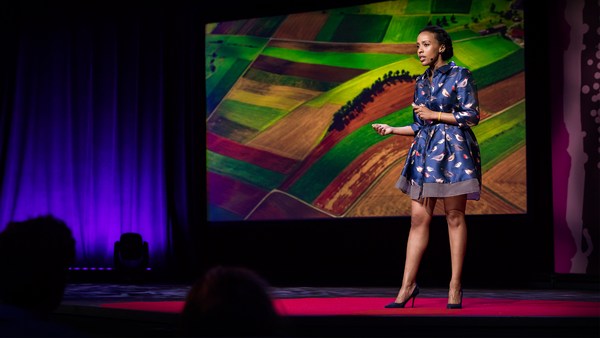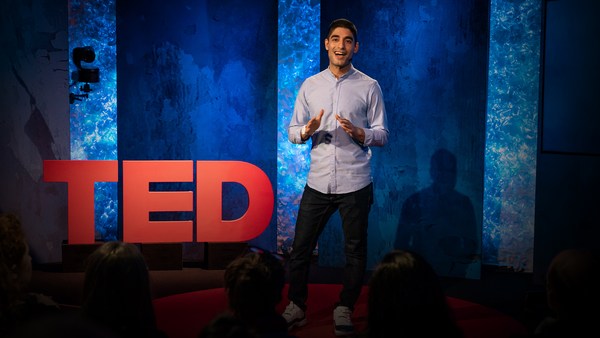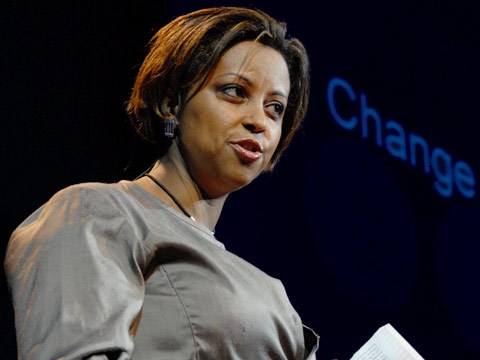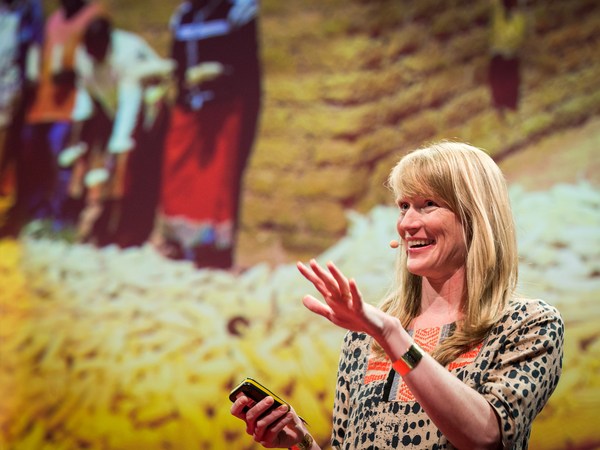So what do people usually say when you're about to give a public talk? It's to imagine that your audience is naked.
(Laughter)
Well, I'm doing a different trick tonight, and I'm going to imagine all of us without farmers, and well, it's not so much different.
[Without farmers you'd be hungry, naked and sober]
(Laughter)
And our farmers do so much more for us than simply feed and clothe and provide us excellent things to drink. Our farmers are an important part of all of our communities, particularly our rural communities. And more than that, they're a strong driver of resilient economics. Think about it this way: When a brewer buys hops from me, grown here in Minnesota, 90 percent of that dollar stays in our state, compared to just 10 percent when they buy it from somewhere else. What that means is a lot. That 90 percent means local jobs. It means tax revenue for better schools and roads. It means support for the co-ops, the mechanics, all the support staff that are needed for a farm to thrive. And they're our best stewards of the land.
This quote, I think, exemplifies what our family farmers do for us in stewarding our shared natural resources. "That land is a community is the basic concept of ecology, but that land is to be loved and respected as an extension of ethics."
Now, they sure do a lot of good stuff for us. And our family farmers are great, we'd all agree. However, the trends in agriculture today are dire. The average age of a farmer in America, according to the latest agricultural census -- 58.3. Of all the farmers, 33 percent are 65 plus. That's a little caricature of my grandpa.
(Laughter)
He's still farming, and he's much older than 65. But to put that in perspective, another important public service job, teaching, average age of teachers is 42. Our farmers are pretty old in this country. And unfortunately, when they retire, if they retire, we're not really replacing them. Of all the farmers that we added in this country between 2008 and 2012, across the entire United States -- see if you can catch this difference -- we added 2,000 under the age of 30. I'm one of those. I'll be around to autograph some photos later, if you'd like.
(Laughter)
But, you know, our farmers are getting older and we're not replacing them -- what's going on here? What are we going to do? And I think there's a reason folks aren't coming into it, and that's prices.
We're going to go through a couple of slides like this. Milk: This is the average retail price of a gallon of milk in the United States. Four dollars forty-nine cents. How much do you think the farmer gets? Dollar thirty-two. We'll try again with bread. Average retail price of bread in America, three forty-nine. Farmer gets ... Twelve cents.
Audience: Oh!
And so how are we supposed to have strong local farms in this scenario? What are we supposed to do if there aren't any local farmers left? And this isn't just a farmer problem, it's not just something for the few of us farmers to sort out. This is an all-of-us problem. This is rural and it's urban and it's statewide and it's nationwide. So what do we do about it? I'll tell you that.
But first, a story. The green movement, we're all kind of familiar, started in the '60s, planting trees. And now we've come such a long way. Green is part of our day-to-day lives. It's part of the day-to-day lives of Fortune 500 businesses. It's the subject of international treaties, the subject of presidential debates. You and I, we switch our light bulbs, we use reusable bags. We participate in the green movement each and every day. Yet ... and this is how we get to the idea -- the food movement, relatively younger, but also somewhat familiar, I imagine.
You go to the grocery store, you see a sign that says "Buy local," you go to the farmers market, you go to the co-op, you read books by prominent authors. The food movement to date could be summarized as voting with your fork. The idea is: you pull a dollar out of your wallet -- how you spend that dollar affects the food system. It supports farmers close to home. And that's all well and good, but where are we going? How do we get to our renewable-energy moment like the green movement did? And this, I think, is what we need to do.
Just voting with our fork is not solving the issues that our farmers are facing. And so we need to do more than that. I believe we must move on from just voting with our fork to voting with our vote. We need to take our dollars and continue to spend them locally. We also need to show up at the ballot box for our farmers. This is bigger than just buying local strawberries once a year at a pick-your-own. This is a year-round effort that we must make together to make the change we need. Changes like fair pricing for farmers. That's quotas, supply management, guaranteed prices. Changes like fair and open trade. That means ending trade wars. And yeah, of course it means voting. Now we all knew that one already, though. For example, it's working.
Hey, who's that?
(Laughter)
Just this year in Minnesota, we've passed a historic, first-in-the-country tax credit. The Beginning Farmer Tax Credit. It incentivizes our transition of land from the existing generation to the next generation. That was done by a handful of us young farmers -- we certainly don't have money, you saw that earlier. We don't have political experience. But we showed up, and we made our voices heard. And thanks to the support of farmers and non-farmers alike, we got something incredible done here in this state. If we can do it, anybody can do it.
Now, that was all light and fuzzy and feels pretty happy. Skeptics in the audience, you're here. That would be me, if I were here. Skeptics are thinking, "Wow, what do we need to change about our food system?" Farmers are great. We have unlimited food, and it's real cheap, too, isn't that great? Well, unfortunately, in the '80s and the '90s in this country, we went down a path of policy that could be described as "get big or get out." And what "get big or get out" means is you maximize production while minimizing costs. On its face value, that sounds pretty simple. However, that shift turned our farmers from a venerated class and a valued class in our society into a cost to be minimized. That shift made it so that my great-grandfather, who supported the family with six cows, that same dairy, trying to support their family, has to be 600 cows today. Six-thousand-cow dairies are not unheard of. What happens when there's this one dairy farm in an entire county, where there used to be hundreds?
The same could be said with corn or beans or field crops. What happens when it takes 10,000 acres for one person to support themselves? When it used to only take 40. We know what happens, we read about it in the news. Broadly determined, rural decline, but schools close, schools consolidate, post offices close, grocery stores close. People leave, the community suffers and goes away.
I believe all of us in this audience with ties to rural Minnesota know this story well. This is not a problem that we can solve with farmers markets and good intentions. We have to do more for our farmers. Policy got us into this mess, and policy can get us out. American farmers are only getting older, fewer and poorer, yet they are crucial to our state. They're the vibrancy in our rural communities. They're the drivers of economic growth and stability, and they are our best protectors of our shared resources of land, water and air. So we have to do better for them.
So join me, would you? Let's fight for our farmers. You can see it, we're already doing it in Minnesota, having great success. And together, we can do even more. And we must. So we were voting with our fork before, and we want to keep doing that. But if I could have one idea for you to go home with today, it's vote with your vote. And so to that end, on the count of three, I'd like all of us to say it together. Are you ready? OK, one, two, three.
Audience: Vote with your vote.
Very nice, thank you. I think you got it.
(Applause)





